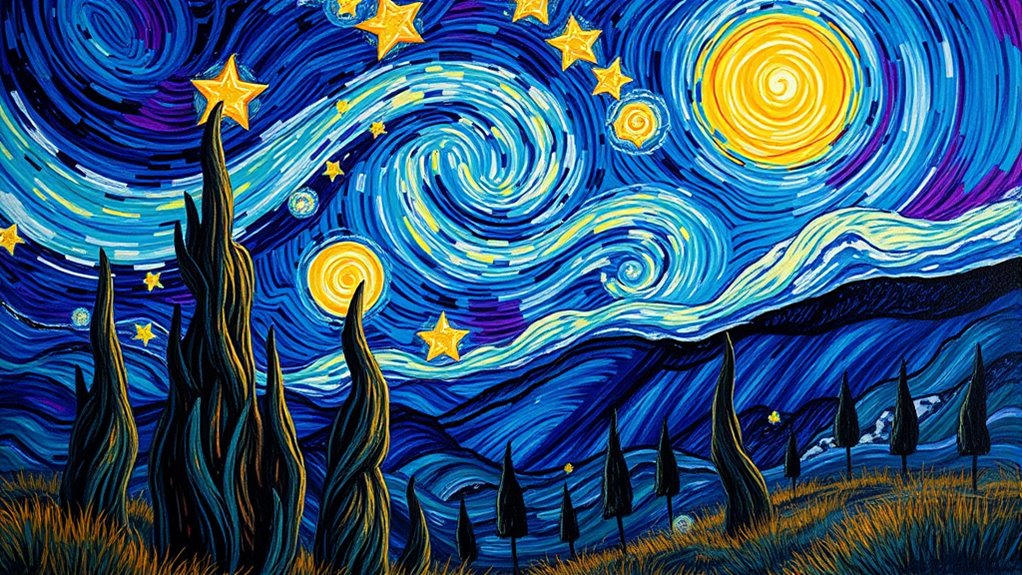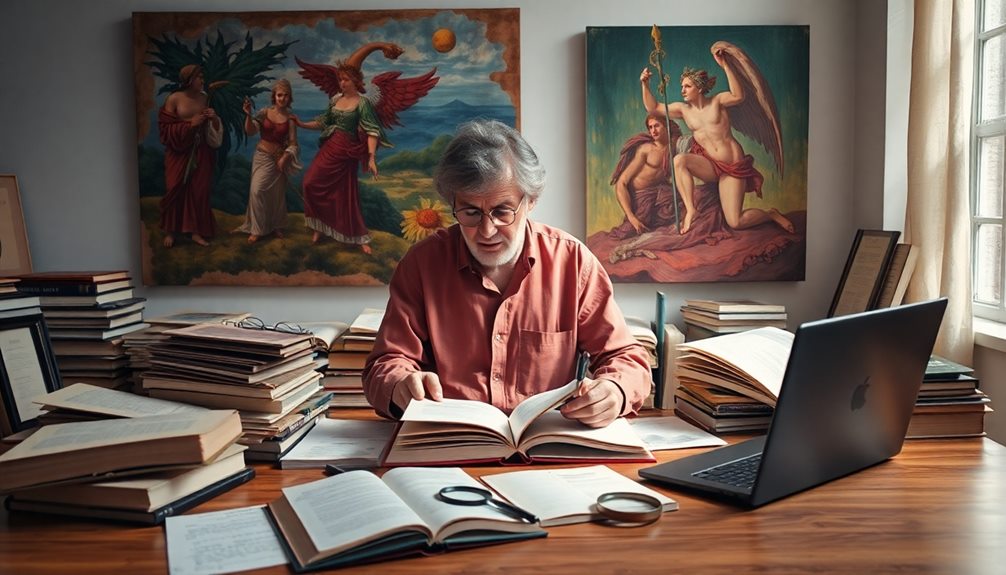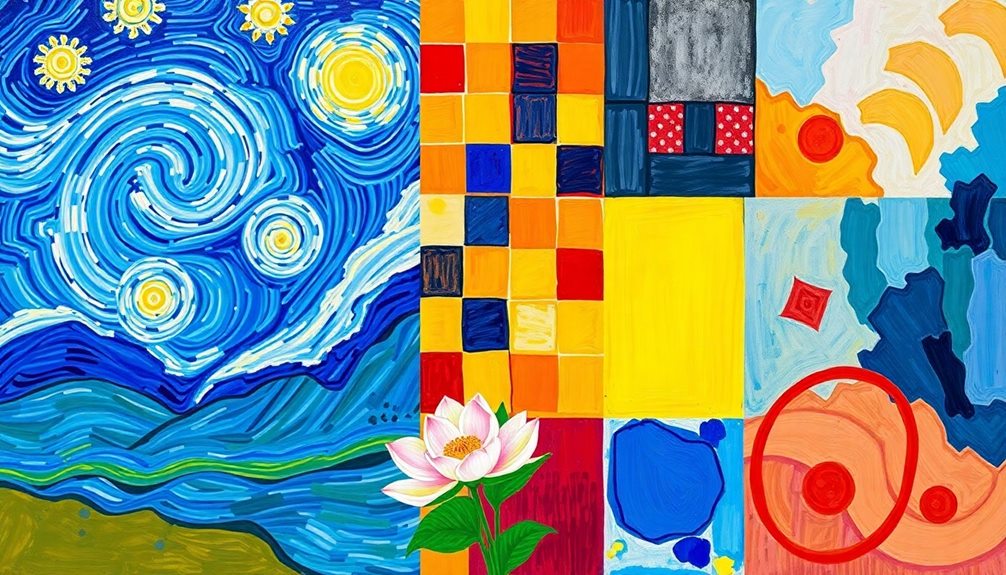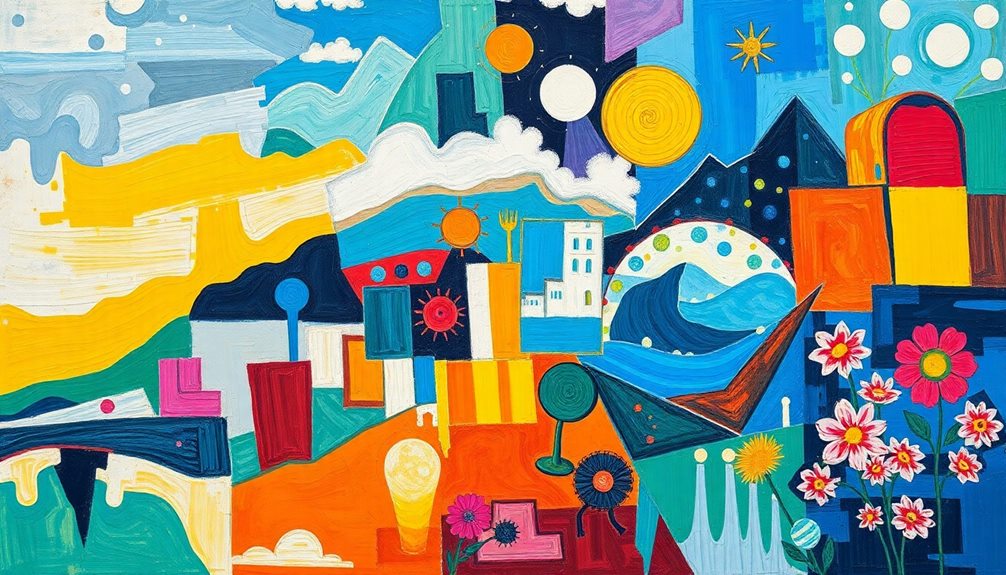Beyond Impressionism, Post-Impressionist art invites you to explore deeper emotional and spiritual expressions through bold colors and symbolic motifs. Artists moved away from naturalistic scenes, experimenting with composition and distorted forms to convey personal meaning and inner feelings. Their innovative techniques emphasize mood, symbolism, and intense brushwork, creating works that speak on a profound level. If you look closer, you’ll uncover rich visual language and ideas that shaped modern art, revealing much more beneath the surface.
Key Takeaways
- Post-Impressionists aimed to express deeper emotional and spiritual truths through innovative use of color and symbolism.
- Color was employed symbolically to evoke feelings, moods, and spiritual meaning, moving beyond naturalistic representation.
- Artists used layered motifs and visual language to convey complex ideas and personal philosophies.
- Unconventional compositions, distorted shapes, and exaggerated lines emphasized emotional and symbolic impact.
- Technical innovations like bold brushwork and deliberate color choices enhanced emotional depth and expressive power.

Have you ever wondered how artists moved beyond Impressionism to explore new ways of expressing emotion and structure? During the Post-Impressionist movement, artists sought to push past the fleeting effects of light and color that defined Impressionism. Instead, they focused on conveying deeper emotional truths, often using innovative techniques rooted in color theory and symbolic motifs. You might notice how Post-Impressionists deliberately used color not just to depict what they saw but to evoke feelings, mood, or spiritual meaning. For example, Vincent van Gogh employed bold, expressive hues—such as vibrant yellows and swirling blues—to communicate his inner turmoil and passion. This approach moved away from naturalistic representation and embraced a more symbolic use of color, where each shade carries emotional weight.
Post-Impressionists used color to evoke emotion and spiritual meaning beyond realistic depiction.
In addition to color theory, symbolic motifs became central to their work. These motifs served as visual language, allowing artists to embed layers of meaning into their paintings. Instead of merely portraying a scene, they infused their works with symbols that conveyed complex ideas or personal philosophies. For instance, Georges Seurat’s pointillist technique used tiny dots of color to build up a composition rich with symbolism, emphasizing harmony and balance. Similarly, Paul Gauguin’s use of bold patterns and symbolic objects in his Tahitian paintings represented a quest for spiritual enlightenment and a rejection of Western materialism. These symbols weren’t always literal; they often required viewers to interpret the deeper significance behind common objects or recurring themes. Furthermore, many Post-Impressionist artists experimented with composition techniques to enhance the emotional impact of their work, breaking away from traditional perspectives to emphasize personal expression. These innovative arrangements often employed unconventional perspectives and distortions that heightened the symbolic meaning and emotional resonance.
You’ll also notice that Post-Impressionist artists experimented with structure and form, breaking away from the naturalistic perspective of Impressionism. They played with distorted shapes, exaggerated lines, and unconventional compositions to better express emotion and symbolism. This shift allowed them to create works that are not just visual impressions but profound statements about human experience, spirituality, and individual perception. Their emphasis on personal vision and emotional impact gave their art a sense of immediacy and intensity that set it apart from their Impressionist predecessors.
Moreover, understanding the Layer Concepts involved in their techniques can deepen your appreciation for how these artists organized complex ideas within their compositions. By exploring color symbolism, viewers can gain insight into the emotional and spiritual messages conveyed through their use of hue and tone. Exploring visual language reveals how Post-Impressionists communicated complex ideas beyond literal representation. Ultimately, moving beyond Impressionism meant embracing a more subjective view of the world—one where color, symbolism, and form all serve to communicate complex feelings and ideas. You can see this in their bold brushwork, deliberate color choices, and the layered meanings behind their motifs. It’s this synthesis of technical innovation and emotional depth that defines Post-Impressionist art and continues to influence artists today.
Frequently Asked Questions
How Did Post-Impressionism Influence Modern Art Movements?
You see that post-impressionism shaped modern art by pushing boundaries beyond impressionist techniques. It encouraged you to explore color theory and emotional expression, fueling artistic innovation. Artists like Van Gogh and Gauguin experimented with vivid colors and symbolic themes, inspiring movements such as Expressionism and Fauvism. This shift empowered you to prioritize personal vision and emotional depth, transforming how art communicates feelings and ideas today.
Which Artists Were Most Pivotal in Developing Post-Impressionist Styles?
Imagine you’re opening a treasure chest of artistic innovation. Artists like Vincent van Gogh, Paul Gauguin, and Georges Seurat are the keys. They develop Post-Impressionist styles through bold color theory and expressive brushstroke techniques, transforming how you see art. Van Gogh’s swirling strokes, Gauguin’s symbolic use of color, and Seurat’s pointillism all push boundaries, inspiring future movements and inviting you to explore deeper emotional and symbolic layers in every piece.
What Role Did Symbolism Play in Post-Impressionist Artworks?
You see that symbolism in post-impressionist artworks plays a crucial role by incorporating symbolic motifs and expressive symbolism. Artists use these elements to convey deeper emotions and ideas beyond mere visual representation. You notice how colors, shapes, and symbols evoke feelings, add layers of meaning, and reflect personal or universal themes. This approach allows viewers to interpret the art more emotionally and intellectually, enriching the overall experience.
How Did Post-Impressionism Challenge Traditional Artistic Conventions?
You challenge traditional artistic conventions by experimenting with color theory and brushwork techniques. Instead of relying on realistic depictions, you use bold colors and expressive strokes to evoke emotion and subjective experience. Your approach breaks away from realistic representation, emphasizing personal vision and emotional depth. By doing so, you push the boundaries of classical art, encouraging viewers to interpret your work on a deeper, more intuitive level.
Are There Any Significant Geographic Differences in Post-Impressionist Art?
Imagine strolling through Paris and then wandering into a small village in Provence; you’ll notice regional diversity shaping post-impressionist art. Cultural influences vary across regions, from bold colors in southern France to more subdued palettes elsewhere. These geographic differences reflect local landscapes, traditions, and histories, making post-impressionist art a tapestry of diverse expressions. Your journey highlights how geography deeply influences artistic styles and themes across different areas.
Conclusion
As you step back from these vibrant, swirling visions, you realize Post-Impressionism isn’t just about colors—it’s like peering through a window into the artist’s soul, where emotion and symbolism dance in harmony. You’ve traveled beyond mere impressions, into a domain where art whispers secrets and paints feelings you can almost touch. This movement invites you to see the world not just as it is, but as it’s felt—alive, mysterious, and infinitely deep.









